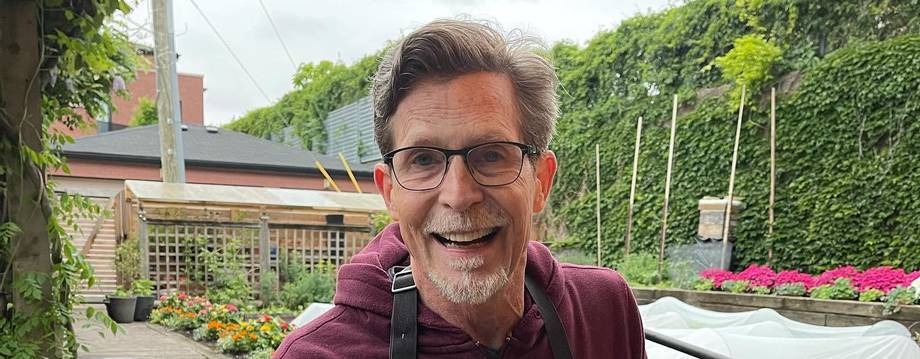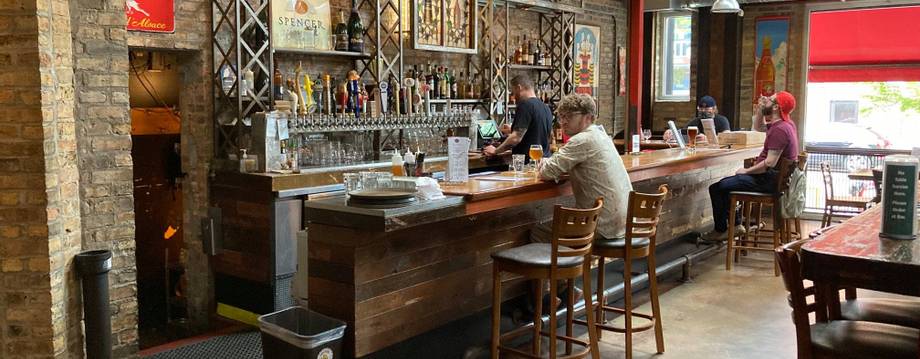Posted Aug 09, 2021

By Jim Ryan, Ferment Chicago
While poet Carl Sandburg once referred to Chicago as the “City of the Big Shoulders” and rocker Billy Corgan reintroduced the idea of “The Windy City” as “The City by the Lake,” “the Second City” has never been at a lack of internationally known cliches.
For decades, one of the least accurate was an attempt to sum up the midwest American city’s culinary offerings in terms of just two items: deep dish pizza and hot dogs (hold the ketchup).
But the year 1987 was a pivotal one that forever changed the course of Chicago cuisine, one which saw the opening of Frontera Grill, featuring the renowned Mexican cooking of chef and restaurateur Rick Bayless, and Charlie Trotter’s, the namesake restaurant of the famed chef who normalized tasting menus and vegetable-based preparations long before they were en vogue, likening the culinary experiences he created to the necessary comprehension of improvisation that drives the best jazz musicians.

PHOTO: Chef Rick Bayless | Facebook
While Trotter almost single-handedly elevated the American expectation of what fine dining could be, moving Chicago away from the chain restaurants and dimly lit steakhouses of yore, he was preceded in the city by Spiaggia, the Michelin-starred Italian eatery which, for 35 years, featured the work of chef Tony Mantuano, who garnered a James Beard Award in 2005, recognition of his status as one of America’s top chefs.
Bayless raised his dining experience even further just two years later, opening Topolobampo in 1989, capping a stretch of Chicago culinary history which continues to ripple throughout the city today, further impacting wider culture.
Trotter alum Curtis Duffy went on to open Grace in 2012, one of the only Chicago restaurants ever to tally three Michelin stars, and presides today over Ever, an ambitious dining experience centred around cuisine as an event, one which racked up two Michelin stars this past April.

Chef Grant Achatz on the far right © Alinea Restaurant
But it’s impossible to examine Chicago cuisine without mentioning Alinea, named one of the world’s 50 best restaurants in 2017. Today, it’s the only Chicago restaurant to retain its three Michelin stars, consistently pushing the American culinary idea forward through evolving concepts and the whimsical work of Beard Award-winning chef Grant Achatz, who logged time at Trotter’s prior to working under Thomas Keller at French Laundry in California.
“I started at Alinea in 2008. At the time, it was very cutting edge,” says Kevin Cuddihee, a corporate chef in Chicago who learned at Alinea under Achatz before striking out on his own. “When I was there, a good portion of our ingredients would come internationally via shipping services. At the time, that was unheard of, to ship stuff to Chicago from Japan or from Europe directly. There was no distance that was too far to go for an ingredient. That always stuck with me.”
Between 2012 and 2019, Cuddihee worked as executive chef at Two, a six time recipient of Michelin’s Bib Gourmand. Located in Chicago’s West Town neighbourhood, the restaurant utilized farm to table sourcing in its micro-seasonally inspired small plates, underscoring one of the biggest factors driving the current evolution of food in Chicago: the easy availability of great ingredients.
“Our world is getting smaller. Our access to ingredients – both food ingredients and in cocktails and wine – is so much closer than it was 20 or 30 years ago,” says Cuddihee, highlighting a concept Trotter could’ve never envisioned. “Every neighbourhood in the city has a farmers’ market now. Whereas, before, you had to travel to get to those things. Now, most people can walk six blocks once or twice a week to a farmers’ market. If they work downtown, there’s one in Daley Plaza on Thursdays. That access has been so great for chefs.”

PHOTO: Green City Market | Facebook
Since 1999, Green City Market has worked in Chicago toward their mission of, “deepening support for sustainable farmers, educating [the] community, and expanding access to locally-grown food.”
Green City operates weekly farmers’ markets on the north and west sides of the city which have become a destination of sorts for chefs and foodies alike. The group works to connect farmers and chefs, profoundly impacting Chicago’s culinary concepts.
“Our founding was really based on the idea that local, fresh, seasonal food should be available to everyone,” says Green City executive director Mandy Moody. “Our founder Abby Mandel worked really closely with Rick Bayless actually, who was one of the founding members of Green City Market. Rick also feels really strongly about local food and supporting your farmers.
“So Rick and Abby were both really big champions of making sure that Chicago’s top chefs understood that they could really lead the way. That by sourcing really phenomenal ingredients directly from farmers – right from the onset of conceptualizing their restaurants – would make them distinctive. A whole community was sort of born out of chefs coming to the market and really getting to know the farmers and the growers. And we’ve worked really hard to help farmers and chefs work together and know that they’re all a part of an ecosystem that is a distinctive culinary scene here in Chicago.”
Chicago’s neighbourhoods are ethnically diverse and working with chefs from across the city lends Green City a virtually unparalleled impact on restaurant menus of all types.
“I think food is so central to everyone’s cultural identity, whatever it is. Food really feels like it’s at the centre. I feel like the way Green City Market contributes to that is we can show that an ingredient like a mushroom, for example, can be used in incredible Asian cuisine, in Mexican food, in German cooking or French cuisine, right? There’s all of these different cultures that stem from this one ingredient that can be reimagined in really endless ways,” says Moody. “When you can have those conversations with your farmer, you can discover all of those cool iterations of an ingredient.”
Once upon a time, restaurant menus would feature the same items throughout the year, regardless of the fact that many ingredients weren’t available locally during Chicago’s harsh winters, lowering the quality of the dish. But, today, dedicated chefs can work year round with Green City farmers to create new and unique dining experiences.
“I’m thinking chefs like Sarah Stegner at Prairie Grass Cafe and Beverly Kim with Wherewithall,” says Moody, referencing Stegner’s suburban Chicago eatery alongside Kim’s restaurant which, for just $65, features a daily changing, four course tasting menu from a Beard Award winning chef. “Those two chefs in particular are so close to our mission. They serve on our board. But you can really see in what they do that there is a very seasonal approach to their menus and how they’re programming what they’re doing at their restaurants.”
Chicago’s neighbourhoods are often defined by their ethnic makeup, an element which, as chefs and restaurants move around – sometimes the result of gentrification – can begin to vastly influence cuisine throughout the city.
There’s perhaps no better example of this than the presence of great Mexican food across the city.
Chicago’s relationship with Mexican food dates back to 1893, when for the first time in the United States, tamales were consumed in Chicago during the World’s Columbian Exposition.
Today, while Bayless features top notch Mexican food heightened by a fine dining experience, Claudio Velez, affectionately known locally as ‘the tamale guy,’ peddles his wares on foot from a handheld cooler, walking from bar to bar to satiate the city’s alcohol-driven, nocturnal cravings. Food trucks like the Tamale Spaceship on the other hand, accommodate Chicago’s downtown workforce during normal business hours while the south side neighbourhood of Pilsen, despite a changing demographic, remains known for the vast scope of its high quality carnitas.

PHOTO: Frontera Grill | Facebook
“You can roll out of a concert or a bar anywhere in the city and walk somewhere and find above average tacos. Which is great,” says Cuddihee. “And then if you go eat a torta at Xoco or tacos at Frontera, it’s an elevated environment,” he continued, noting two Bayless establishments. “But it’s still very traditional – like what you would find in Mexico City. And I think the respect he gives to the cuisine is almost unparalleled. You don’t always see that. He’s such a champion for Mexican cuisine.”
Perhaps the biggest evolution in Chicago’s cuisine can be found in bars and breweries.
In the 80s and 90s, it was almost expected that bar food would be passable at best, usually frozen or fried, and often downright bad.
Today, that’s not accepted. And it’s a concept that started in Andersonville, a neighbourhood with Swedish roots on Chicago’s far north side which today features one of Chicago’s highest LGBTQ+ populations.
Since 1992, Andersonville has been home to one of the city’s best beer bars: Hopleaf, one which features fantastic food at an affordable price in a cozy environment, the yin to Alinea’s yang and proof that Chicago’s foodie scene today caters to all walks.

PHOTO: Hopleaf | Facebook
“At that point there were some bars that were carrying better beer and trying to sort of bring beer and food culture together and all of this stuff – but there was nobody digging deep into it. I had been very interested in the Belgian beer scene and there was no one else doing that,” says Hopleaf owner Michael Roper. “When we first opened, we were not a food destination, we added the kitchen later. But it was always part of the concept to eventually get to the point where we could build out a kitchen. Back then, it was like beer and burgers, beer and pizza. And I said: ‘There are places in the world where beer has an equal place on the table with French wine and high quality spirits.’ And I wanted to do that in Chicago.”
For decades in America, the ideas of great food and beverages tended to be mutually exclusive. The idea of centring a bar around great beer was virtually non-existent.
Hopleaf provided a viable path forward for future Chicago culinary tastemakers like Publican Quality Meats, who focus on great food and drink in an elevated dining atmosphere under Beard nominated chef Paul Kahan.
In April, Moody Tongue Brewing on the city’s near south side notched a pair of Michelin stars, proof positive that drilling down on the idea of phenomenal food and beer can work.

PHOTO: Moody Tongue Brewing | Facebook
But it wouldn’t have been possible without Hopleaf, who’s brought together elements of virtually every Chicago demographic under one roof for nearly three decades, classism out the window when the food and drink menu is superior.
“We bought the building in 2000 which allowed us, finally, to have the freedom and the space to build out our kitchen,” says Roper. “The other thing that allowed us to do was to have the kind of classic Chicago, tin ceiling barroom, with a woody, pre-prohibition bar and all of that stuff in the front. And then you could walk to this backroom which was a regular dining room, so that you could combine the experience of a Chicago working man’s tavern in aesthetics with a place that had nice table service and really interesting beer.
“We were among the first, if not the first, at least in America, to do some of the things that we were doing. There’s no reason why really good food in a beer venue has to be snooty and formal. We can have that tavern atmosphere where a working class person from the neighbourhood can walk in and somebody from the North Shore can be sitting at the table next to them all enjoying the same kind of thing in a convivial, informal tavern atmosphere. I think that’s something that really happens in Chicago. We’ve got places like that.”
Article from Ferment Chicago.